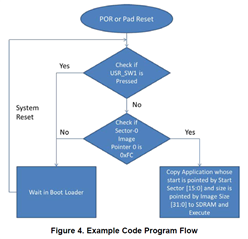Dear Charles Tsai,
I hope this message finds you well. I am writing to report an issue with the MSP432 microcontroller unit, specifically related to booting from the External SDRAM starting address is 0x60000000.
As you recommended I have downloaded www.ti.com/.../TIDM-TM4C129SDRAMNVM the software collateral and gonethrough the ektm4c129_qssi_bootloader code and ektm4c129_qssi_boot_demo1 Application code.So I created simple hello world(UART Print)Application and Modified the linker script as per the ektm4c129_qssi_boot_demo1 Application code.
In Bootloader code Initialized the SDRAM and receiving the Application .bin file through Xmodem and write into the SDRAM.For the time being am not using Qssi Flash i am receiving the application through SDRAM and directly writing the data to the SDRAM.I verified the Application bin file data after reading data data from the SDRAM.so i confirmed am writing the data properly to the SDRAM but i could't able to run over the SDRAM.here below am attaching my application linker script and entry point code for your reference.
APPLICATION LINKER SCRIPT
SDRAM start address = 0x60000000
here below i will share the linker script file and image for your reference.
Linker script file of hello world project
CRC table operator cannot be associated with empty output section */
--diag_suppress=10199
--retain=interruptVectors
#define APP_BASE 0x60000000
#define RAM_BASE 0x60100000
/* System memory map */
MEMORY
{
/* Application stored in and executes from internal flash */
FLASH (RX) : origin = APP_BASE, length = 0x00100000
/* Application uses internal RAM for data */
SRAM (RWX) : origin = 0x60100000, length = 0x00040000
}
/* Section allocation in memory */
SECTIONS
{
.intvecs: > APP_BASE
.text : > FLASH
.const : > FLASH
.cinit : > FLASH
.pinit : > FLASH
.init_array : > FLASH
.vtable : > RAM_BASE
.data : > SRAM
.bss : > SRAM
.sysmem : > SRAM
.stack : > SRAM
}
__STACK_TOP = __stack + 256;
in main.c i am calling the entry point
static void (*appEntry)();
UINT32 entryPiont;
entryPiont = 0x60000000;
appEntry = (void (*)(void))entryPiont;
(*appEntry)();
Expecting Solution:
After writing into SDRAM it have to boot from the SDRAM for that what are the things i have to modify.Initially am not using QSSI flash i am trying after receiving bin file through Xmodem am writing in to SDRAM and it have to run on it.
Request for Assistance: We are seeking your expertise and support in identifying the cause of this booting issue and finding a suitable solution to ensure that the MSP432 MCU boots from the correct SDRAM address (0x60000000) as intended.
Thank you for your time and attention to this matter. We look forward to your prompt response.
NOTE: sorry for the delay in response because i was concentrated on other pending task. Please advise on any specific steps we should take to diagnose and rectify the problem. Your guidance in resolving this issue would be greatly appreciated.
If you can arrange the call, that would be very beneficial in solving the issue, and we can move forward.
Best regards,
J.Manikandasamy



